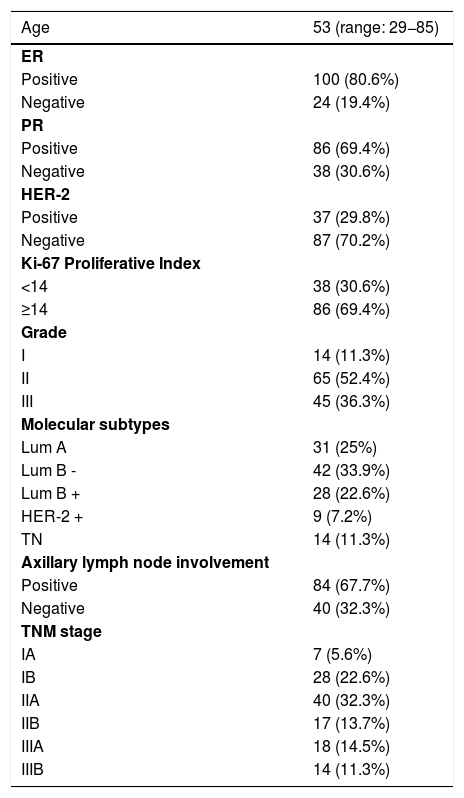This study investigates whether textural features (TFs) extracted from 18F-FDG positron emission tomography/computed tomography (PET/CT) are associated with immunohistochemical characteristics (IHCs) of invasive ductal breast carcinoma (IDBC).
Materials and methodsThe relationship of TFs with IHCs [estrogen receptor (ER), progesterone receptor (PR), human epidermal growth factor receptor-2 (HER-2), Ki-67 proliferation index, and histological grades] from solely excised primary tumors were evaluated for a more accurate assessment. Therefore patients with early-stage IDBC who underwent pre-operative 18F-FDG PET/CT scan for staging were included in this retrospective study. The clinical staging was performed according to the 8th edition of the American Joint Committee on Cancer. Maximum standardized uptake value (SUVmax) and 37TFs of the primary tumor were extracted from 18F-FDG PET/CT. Spearman’s rank correlation test was used to evaluate the correlation between TFs and SUVmax. Receiver operating characteristic curves were generated to define the diagnostic performance of each parameter. Among these parameters, those with the highest diagnostic performance were included in the multivariate logistic regression model to identify the independent predictors of histopathological characteristics.
ResultsA total of 124 patients were included. Histogram-uniformity, grey-level co-occurrence matrix (GLCM), GLCM-energy, and GLCM-homogeneity showed a strong negative correlation with SUVmax, while grey-level run-length matrix (GLRLM), GLRLM-SRHGE, grey-level zone length matrix (GLZLM), GLZLM-HGZE, GLRLM-HGRE, GLCM-entropy, GLCM-contrast, histogram-entropy, and GLCM-dissimilarity showed a strong positive correlation. Some of the TFs were independently associated with ER-negativity, PR-negativity, HER-2-positivity, and increased Ki-67 proliferation index (GLCM-contrast, GLZLM-GLNU, histogram-uniformity, and shape-sphericity respectively). While SUVmax had an independent association with high-grade and triple-negativity, GLZLM-SZLGE, a high-order TF that shows the distribution of the short homogeneous zones with low grey-levels, had an independent association with axillary lymph node metastasis.
ConclusionsER-negative, PR-negative, HER-2-positive, triple-negative, high-grade, highly proliferative, and high-stage tumors were found to be more glycolytic and metabolically heterogeneous. These findings suggest that the use of TFs in addition to SUVmax may improve the prognostic value of 18F-FDG PET/CT in IDBC, as certain TFs were independently associated with many IHCs and predicted axillary lymph node involvement.
Este estudio investiga si las características de textura (TF) extraídas de la tomografía por emisión de positrones/tomografía computarizada (PET/TC) con fluoruro-18 fluorodesoxiglucosa (F-18 FDG) están asociadas con las características inmunohistoquímicas (IHC) del carcinoma ductal de mama invasivo (IDBC).
Materiales y métodosSe evaluó la relación de TF con IHC [receptor de estrógeno (ER), receptor de progesterona (PR), receptor 2 del factor de crecimiento epidérmico humano (HER-2), índice de proliferación Ki-67 y grados histológicos] de tumores primarios extirpados únicamente para una evaluación más precisa. Por lo tanto, los pacientes con IDBC en estadio temprano que se sometieron a una exploración por PET/TC con F-18 FDG pre-operatoria para la estadificación se incluyeron en este estudio retrospectivo. La estadificación clínica se realizó de acuerdo con la 8a edición del American Joint Committee on Cancer. El valor máximo de captación estandarizada (SUVmáx) y 37 TF del tumor primario se extrajeron de F-18 FDG PET/TC. Se utilizó la prueba de correlación de rango de Spearman para evaluar la correlación entre TF y SUVmáx. Se generaron curvas de características operativas del receptor para definir el rendimiento diagnóstico de cada parámetro. Entre estos parámetros, aquellos con mayor rendimiento diagnóstico se incluyeron en el modelo de regresión logística multivariante para identificar los predictores independientes de las características histopatológicas.
ResultadosSe incluyeron un total de 124 pacientes. La uniformidad del histograma, la energía GLCM y la homogeneidad GLCM mostraron una fuerte correlación negativa con SUVmax, mientras que GLRLM-SRHGE, GLZLM-HGZE, GLRLM-HGRE, GLCM-entropía, GLCM-contraste, histograma-entropía y GLCM-disimilitud mostraron una fuerte correlación positiva. Algunos de los TF se asociaron de forma independiente con ER-negatividad, PR-negatividad, HER-2-positividad y aumento del índice de proliferación de Ki-67 (GLCM-contraste, GLZLM-GLNU, histograma-uniformidad y forma-esfericidad respectivamente). Mientras que SUVmax tuvo una asociación independiente con alto grado y triple negatividad, GLZLM-SZLGE, un TF de alto orden que muestra la distribución de las zonas homogéneas cortas con niveles de gris bajos, tuvo una asociación independiente con metástasis en los ganglios linfáticos axilares.
ConclusionesSe encontró que los tumores ER negativos, PR negativos, HER-2 positivos, triple negativos, de alto grado, altamente proliferativos y en estadio alto eran más glucolíticos y metabólicamente heterogéneos. Estos hallazgos sugieren que el uso de TF además de SUVmax puede mejorar el valor pronóstico de F-18 FDG PET/TC en IDBC, ya que ciertas TF se asociaron independientemente con muchas IHC y predijeron la afectación de los ganglios linfáticos axilares.
Article

Revista Española de Medicina Nuclear e Imagen Molecular (English Edition)









